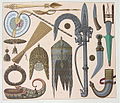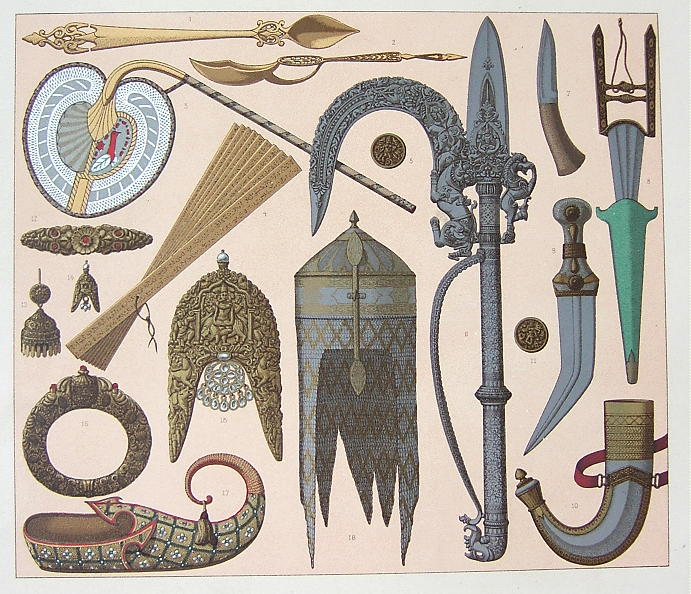Archivo:Racinet2.jpg
De LibreFind
Saltar a: navegación, buscar
Racinet2.jpg (691 × 594 píxeles; tamaño de archivo: 120 KB; tipo MIME: image/jpeg)
Este archivo es de Wikimedia Commons y puede usarse en otros proyectos. La descripción en su página de descripción del archivo se muestra debajo.
Resumen
| Artista |
ALBERT RACINET, Paris |
| Descripción |
"India, that country full of luxurious vegetation, rich in natural products of every kind, with inexhaustible mines of precious metals and stones, displays her character of overflowing abundance and the fantastic spirit of her inhabitants also in the productions of her art. But notwithstanding her old and comparatively high civilization, a certain conservatism, extending for nearly a thousand years to the social and religious conditions and, institutions, exercised, as a matter of course, its unavoidable influence also on the artistic productions, especially when you look on the caste-like separation of the several trades. Only since the beginning of our century can we report new introductions in the Indian art. Being little conventional and flowing freely, Indian ornament - seems to have the greatest affinity with the Persian style. The surface decoration, never losing its specific character, mostly exhibits a very profuse richness of recurring motives, and a grand splendour of colouring which, far from harassing the eyes of the beholder, affords, on the contrary, a salutary repose to them. The outlines of the design, in which all modelling is avoided, are generally executed on light ground in deeper colours than the pattern itself, and on dark ground-in light colours. The Indians found their principal motives, as seems most likely, among their native plants, employing in the first place lotus, excellently drawn roses, pinks, granates, etc.; but most frequently, especially in modern productions, we meet with the palm-branch always-treated conventionally. Fig. 1 and 2. Wooden spoons from Calcutta used for cream, Fig. 3. Bengalese fan used in Indian homes. The handle is made of wood, the fan part of silk and satin. The first fans used in India were made of palm leaves. They were used against flies, also a tail of the yak (Tibetan steer)) was used for this purpose, Fig. 4. depicts a book made of elongated wooden tablets tied together with a wire, Figs. 5, 11, 12, 13, 14, 15, and 16. depict various buttons, brooches, buckles made of embossed and chiseled gold, embellished with various precious stones, diamonds and pearls, Fig. 6. Antique steel hook used by elephant riders, Fig. 7. Little knife from Nepal, Fig. 8. A khouttar, Indian dagger, distinguished by its sheath covered with velvet. This weapon is only known in Hindustan, Figs. 9 and 10. Another dagger with a bent-shaped blade, strengthened along its length with a raised rib. This type of dagger was not attached to a belt but was carried hanging from it, Fig. 17. Depicts a shoe of a nahab. The fabric is made of golden filaments, embroidered with silk and pearls, Fig. 18. A helmet of a mogul from the 16th Century, the top is highlighted by a pyramid-shaped button, the front has the nose protector." |
| Fecha |
1878 date QS:P571,+1878-00-00T00:00:00Z/9 |
| Fuente/fotógrafo | http://www.columbia.edu/itc/mealac/pritchett/00routesdata/1700_1799/localrulers/weapons/xracinet.html |
Licencia
| Public domainPublic domainfalsefalse |
Este trabajo es de dominio público en Francia por una de las siguientes razones:
العربية ∙ English ∙ español ∙ français ∙ 日本語 ∙ 한국어 ∙ македонски ∙ русский ∙ Tiếng Việt ∙ 简体中文 ∙ 繁體中文 ∙ +/− |
 |
Historial del archivo
Haz clic sobre una fecha/hora para ver el archivo a esa fecha.
| Fecha y hora | Miniatura | Dimensiones | Usuario | Comentario | |
|---|---|---|---|---|---|
| actual | 13:16 23 oct 2011 |  | 691 × 594 (120 KB) | Sridhar1000 | ............. |
Usos del archivo
La siguiente página enlaza a este archivo:
Metadatos
Este archivo contiene información adicional, probablemente añadida por la cámara digital o el escáner usado para crearlo o digitalizarlo.
Si el archivo ha sido modificado desde su estado original, pueden haberse perdido algunos detalles.
| Título de la imagen | Sierra Exif JPEG |
|---|---|
| Fabricante de la cámara | TOSHIBA |
| Modelo de cámara | PDRM81 |
| Tiempo de exposición | 1/75 seg (0,013333333333333) |
| Número F | f/2,9 |
| Calificación de velocidad ISO | 100 |
| Fecha y hora de la generación de los datos | 15:16 14 may 2002 |
| Orientación | Normal |
| Resolución horizontal | 72 ppp |
| Resolución vertical | 72 ppp |
| Software usado | Digital Camera PDRM81 Ver1.10 |
| Fecha y hora de modificación del archivo | 19:53 18 jun 2007 |
| Posicionamientos Y y C | Co-localizados |
| Programa de exposición | Programa normal |
| Versión de Exif | 2.1 |
| Fecha y hora de la digitalización | 15:16 14 may 2002 |
| Significado de cada componente |
|
| Velocidad de obturación APEX | 6,2 |
| Apertura APEX | 3,1 |
| Sesgo de exposición | 0 |
| Valor máximo de apertura | 3,1 APEX (f/2,93) |
| Modo de medición | Puntual |
| Fuente de luz | Desconocido |
| Flash | No se disparó el flash |
| Versión admitida de Flashpix | 0100 |
| Espacio de color | sRGB |
| Fuente de archivo | Cámara digital |
Obtenido de «http://librefind.wikis.cc/wiki/Archivo:Racinet2.jpg»
